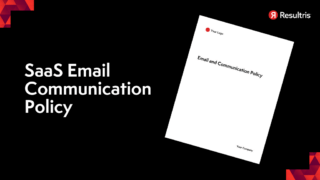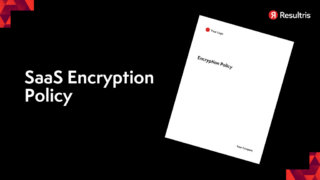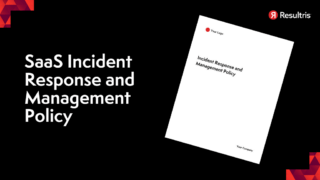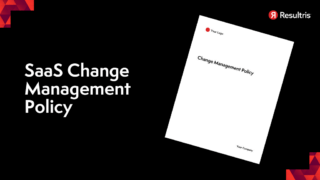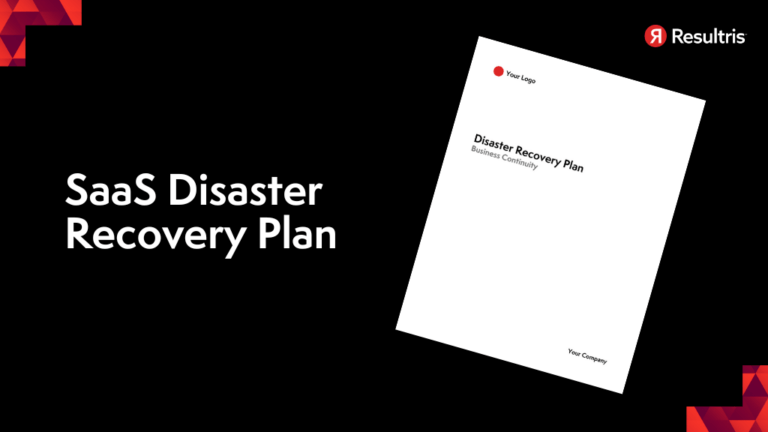
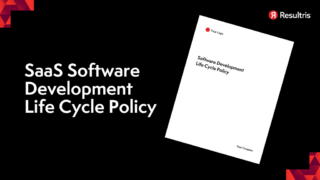
Written by: Tim Eisenhauer
Last updated:

Imagine a scenario where your entire business’s data vanishes in an instant due to an unforeseen disaster. A nightmare, isn’t it? That’s where a robust SaaS Disaster Recovery Plan steps in, turning this nightmare into a mere hiccup.
Securing your business’s data isn’t just an option—it’s a necessity. And when it comes to SaaS platforms, it’s even more crucial. From natural disasters to cyber-attacks, the threats are endless. But don’t worry, we’ve got you covered with our SaaS Compliance and Security Best Practices.
Navigating the waters of SaaS disaster recovery can be a complex journey. But it’s hardly uncharted territory. This section serves as a compass, helping you explore the intricate landscape.
A SaaS Disaster Recovery Plan acts as a safety net for your business’s data, designed to ensure high availability and limit the impact of a data loss event.
A SaaS Disaster Recovery Plan, a facet of your broader cloud backup strategy, aims to restore data and applications swiftly after a disaster. It outlines policies and procedures, detailing actions you’d take in the event of a disaster.
When disaster strikes, SaaS Business Continuity isn’t a wishful thought, it’s a necessity. A robust SaaS disaster recovery plan enables swift restoration of services, keeping business disruptions at a minimum and ensuring continuity.
Disasters aren’t selective. They disrupt irrespective of the size or industry of your business. Recognizing the various types can fortify your IT disaster preparedness.
Natural disasters, while comparatively rare, can cause significant damage to your infrastructure. Whether it’s a tsunami washing away server farms or an earthquake rattling your data centers, these uncontrollable events pose serious threats.
Technological failures are often overlooked. But whether it’s a network outage or hardware failure, these events can cause just as much damage, if not more, than a natural disaster.
In the digital age, cyber-attacks present a potent threat. From denial of service (DoS) attacks to malware infestations, the threat landscape is ever-evolving.
Behind every sophisticated technology sits a flawed human. Mistakenly deleted files or misconfigured servers, human error remains a leading cause of data loss. Hence, a comprehensive disaster recovery plan must also account for such unforeseen errors.
With a clear and concise understanding of SaaS Disaster Recovery, you’re now equipped to implement a data recovery policy tailored to your business needs. Remember, preparation is always better than finding yourself in the midst of disaster unprepared.
As you steer your SaaS business journey through turbulent times, complying with prevailing industry-specific regulations and data protection laws becomes a key fixture in your disaster recovery plan. Let’s dig a little deeper into these and examine how they shape your IT disaster preparedness.
Forging a disaster recovery policy isn’t a one-size-fits-all strategy. Your SaaS business continuity plans must intertwine with industry-specific regulations. From the healthcare industry complying with the Health Insurance Portability and Accountability Act (HIPAA) to the financial services sector adhering to the Sarbanes-Oxley Act (SOX), tailoring your recovery strategies to these regulatory requirements necessitates constant vigilance.
Beyond industry regulations, your cloud backup strategy must mirror data protection laws. Drawing correlations with these can arm your SaaS organization with the right level of data protection and regulatory compliance.
Several SaaS firms cater to the European region, hence General Data Protection Regulation (GDPR) cannot be ignored. GDPR takes a hardline stance on data privacy, mandating businesses to safeguard personal data of their European customers. This is where your disaster recovery plan comes in. Develop data recovery policies that can retrieve lost data without compromising the privacy of your users.
Just as GDPR tackles data protection in Europe, California’s Consumer Protection Act (CCPA) on the other hand, has a similar role in the United States. Other geographies harbor similar regulations, affecting your disaster recovery strategies. It is imperative, then, that your plan can cater universally, ticking off compliance checklists while ensuring minimal service disruptions even in the face of disasters.
Crafting an ace disaster recovery plan isn’t something left to chance – it requires systematic effort. Here, we dissect the chief components of such a plan for SaaS businesses.
Assessing potential risks plays a pivotal role in any disaster recovery plan. Analyzing the consequences of these risks on your business – also known as Business Impact Analysis – makes a wholesome start. This duo acts as your first line of defense, pinpointing vulnerabilities and evaluating their implications. By identifying risks and their potential business effects, you’re poised to design a proactive response and ensure your SaaS business continuity.
Defining your RTO and RPO provides a clear-cut understanding of downtime tolerances. RTO is the maximum duration your functions can afford to be offline post-disaster, while RPO illustrates how far back in time your data recovery can go. It’s more or less your cloud backup strategy’s framework. Explicitly stating your RTO and RPO not only aids in planning but also serves as an essential guideline during actual disaster recovery.
Creating a disaster recovery team is paramount to managing IT disaster preparedness. This team, comprising individuals with specified roles and responsibilities, spearheads the recovery efforts. From data restorers to problem solvers, disaster recovery isn’t a one-person show. Having a dedicated team accelerates the recovery process, enhancing your chances of restoring normalcy swiftly post-disaster.
During a disaster, clear and prompt communication presents a steady beacon amidst chaos. A comprehensive communication plan includes:
Effective internal communication ensures your team understands their roles and the steps they should perform during recovery. This cohesion eliminates confusion, providing direction during a crisis.
Keeping customers in the loop is crucial. Proactive customer communication during disaster management maintains trust and informs your clients about the status of their data and services.
Informing stakeholders about your disaster management steps is essential. By being transparent about the crisis and the steps you are taking, you reaffirm their trust and can allay potentially troubling speculative shadows.
Remember, a SaaS Disaster Recovery Plan is not limited to these components. Your overall data recovery policy might need several tweaks based on your unique business settings and compliance requirements. However, these elements provide a stable foundation on which to build and customize a robust disaster recovery plan.
Let’s move on to a critical stage of safeguarding your SaaS business continuity: creating your bespoke Disaster Recovery Plan (DRP).
Important as step one, identify vital systems and data integral to your SaaS business function. Not all business aspects contribute equally, so focus on systems and data your business can’t do without. For instance, a customer relationship management system proves essential for businesses relying on active client communications. Your focus is enduring a minimum business disruption during an unanticipated disaster.
Now that your crucial systems and data are outlined, your task is picking the fittest disaster recovery strategy. Let’s look at some popular strategies:
A common strategy includes creating regular backups of your data. Consider how often you’ll backup your data and the method used. This approach, however, requires more time to restore applications and data, which can lead to downtime.
Alternatively, strategies like disaster recovery sites exist. Known as cold, warm, or hot sites, they offer varying degrees of operational readiness post-disaster. Decide based on your budget and the urgency to be up and running; hotter means quicker recovery but higher costs.
Cloud-based disaster recovery services have been growing in popularity. They are scalable, reliable, and you pay for only what’s needed, unlike having physical disaster recovery sites.
Your next focus is determining the data backup and replication strategy. Always safeguard your customer data and maintain regulatory compliance.
Depending on your RPO, determine the frequency of backups. Frequent backups ensure minimized data loss. Next, pick between the full, incremental, or differential backup methods. The choice hinges on your time, storage, and recovery speed needs.
Once your data is backed up, ensure it’s stored off-site, protecting it against local disasters. Modern options include cloud or tape storage, both with their pros and cons. Cloud storage offers easy scalability and access, but costs may increase substantially with increased data. Conversely, tape storage provides cost-effectiveness but suffers from slower restore times.
Diving deeper into a SaaS disaster recovery plan, let’s elucidate some of the pivotal technical considerations.
When talking about infrastructure, two things come to the front – redundancy and failover systems, along with load balancing and auto-scaling.
Redundancy acts as a safeguard, providing extra instances of crucial components within your infrastructure. In a failover situation, these redundancies ensure continuous operation, minimizing downtime. Failover systems form the backbone of SaaS business continuity, with provisions enacted to reroute system operations to secondary systems during an outage.
Load balancing distributes workloads across multiple resources to maximize efficiency and maintain system stability. Auto-scaling, on the other hand, refers to adding or subtracting resources based on real-time demand. This combination facilitates a cloud backup strategy that ensures optimal resource allocation and reduces outage risks.
The choice of data center or cloud provider plays a substantial role in data recovery policy. A reliable provider offers robust security features and complies with all regulatory needs. For SaaS providers, this choice directly influences IT disaster preparedness, with an emphasis on advanced security measures, scalability, and reliable customer support.
Your network’s resilience, especially during disasters, is a crucial factor to keep in mind when working on a disaster recovery plan. Implement advanced reliability features, such as redundant links and automatic failover systems. This ensures your system can sustain external shocks and resist network failures, making your SaaS solution more resilient.
Last but not least, application-level recovery strategies hold significant importance. These range from maintaining application backups to setting preventive security measures. Implementing such strategies safeguards against code and application-specific errors, effectively completing your comprehensive SaaS Disaster Recovery Plan.
In managing your disaster recovery plan, a specific focus on the operational elements is vitally important. Orchestrating a seamless transition during an IT disaster hinges on these aspects. Paying attention to the minute details, hence, makes a significant difference.
An essential operational facet of your SaaS Disaster Recovery Plan lies in the Incident Response Procedures. A swift, well-executed reaction to any incident keeps your business functioning, allowing for minimal service disruption. Implementing a robust, clearly defined incident response procedure forms your first line of defense during a disaster. This process typically involves identifying and recording the incident, assessing its impact, activating the Disaster Recovery (DR) team, and recovering or restoring the systems or services affected. In each step, precision and speed have precedence. After all, your business continuity is at stake.
A potential IT disaster requires you to have an Emergency Operations Center (EOC) that acts as the nerve center of the disaster response. This center focuses on communications, resource allocation, and decision-making during a crisis. The EOC doesn’t necessarily need to be a physical location. Indeed, a virtual setup also serves the purpose, so long as it ensures seamless communication and coordination.
How well your staff responds to a disaster often defines the success of your disaster management efforts. As such, Employee Training and Awareness form a crucial part of operational disaster recovery. Employ a combination of relevant training programs, drills, and awareness campaigns to ensure your team knows how to act when disaster strikes. Remember, even the best-laid plans can falter if not executed correctly.
Last but not least, Documentation and Record Keeping are pivotal for your SaaS Disaster Recovery Plan. An accurately documented recovery plan serves as a guide for your team during crisis management, dictating how each recovery procedure must unfold. Concurrently, it’s also a practical reference tool for auditing and continuous improvement. Keeping meticulous records of your disaster recovery process facilitates a comprehensive post-disaster review, enabling you to refine and improve your disaster recovery strategy for future incidents.
Altogether, these operational aspects work in unison, forming a sturdy backbone for your disaster recovery endeavors. Your SaaS business continuity might depend on them.
Securing your company’s data can be a serious investment, however, the financial implications of a disaster can be far more detrimental to your business. This section will discuss the financial aspects you must consider while planning your SaaS disaster recovery (DR) strategy.
Allocating funds for your disaster recovery plan is a critical step. Funding affects the technology you select, the resources available, and the level of protection your SaaS business continuity plan provides. You must consider costs for off-site data storage or cloud backup strategies, infrastructure upgrades, employee training, regular testing of the DR plan, and possible consulting fees.
For instance, a robust cloud backup strategy might seem expensive initially. Yet, it might save you from a complete data loss scenario that could endanger your company’s existence.
Transferring risk through insurance coverages can minimize potential financial losses during a disaster. Traditional business insurance policies may not cover data loss, so it’s essential to invest in specialized insurance that provides coverage for cyber threats and other IT-related issues. For instance, a cyber insurance policy covers data breach costs, enabling you to revamp your IT system without a significant financial burden.
Consider performing a cost-benefit analysis to gauge the effectiveness of various disaster recovery solutions. This analysis helps to identify the solutions that provide maximum benefit for the cost incurred, ensuring your investment is optimized.
For example, you may find that investing in an automated data recovery policy offers higher long-term benefits compared to manual backup plans. Though costing more upfront, automated systems reduce the probability of data loss, giving you peace of mind and securing the continuity of your business.
Balancing these financial considerations ensures your disaster recovery plan not only meets IT disaster preparedness standards but also aligns with your business financial capabilities and priorities.
Let’s delve into the operational aspects of implementing your SaaS disaster recovery plan.
Understanding the need for integration with business continuity planning isn’t just an afterthought; it’s basic survival. Remember, your SaaS business continuity rests on the robust fusion of your disaster recovery plan and overall business continuity planning. The integration process includes synchronizing data recovery policies with your continuity strategy to ensure a streamlined recovery operation when disaster strikes. This integration serves to minimize downtime and prevents unnecessary disruption to vital business operations.
Ever heard that change is the only constant in life? Well, the same applies to your IT disaster preparedness. Your disaster recovery plan isn’t a one-and-done document. It’s constantly in flux, adapting to new technologies, risks, and business growth. Effective change management and routine plan maintenance provide a responsive framework adaptable to an evolving business landscape. Regular updates of your cloud backup strategy and changes to your network architecture keep your plan fresh, comprehensive, and well-maintained.
A disaster recovery plan that’s never tested is like a car that’s never driven— you can’t know if it’ll actually get you where you need to go when it matters the most. Regular testing unearths any overlooked vulnerabilities and provides tangible metrics to validate your recovery capabilities.
Think of table-top exercises as a constructive rehearsal of your disaster recovery plan. These are scenario-based routines where the disaster recovery team maps out the steps of the recovery process. They’re great to clarify roles and responsibilities and identify potential obstacles in the recovery roadmap.
Now comes the real test— full-scale simulations. It’s like a fire drill but for your IT systems. These drills mimic an actual disaster, bringing together all elements of the recovery plan. Checking the effectiveness of your data recovery policy, validating cloud backup strategy, and assessing the readiness of your team, full-scale simulations deliver insights into the real-world viability of your SaaS disaster recovery plan.
Evaluating your SaaS Disaster Recovery Plan’s (DRP) performance doesn’t stop at deployment, it’s a continuous track of processes intertwined with your business strategies. Broadly, the measurement can be conducted under two H3 subheadings:
Key Performance Indicators (KPIs) propel effective decision-making in your DRP. For a DRP, KPIs incorporate metrics like Recovery Time Objective (RTO) and Recovery Point Objective (RPO). Let’s dive a bit deeper:
A thorough analysis of RTO and RPO provides insights into your IT disaster preparedness and the efficiency of your cloud backup strategy.
Your DRP isn’t a fixed, immovable edifice. It needs to grow, adapt, and improve – like your business itself. Continuous improvement aims to refine your approach with steady, ongoing changes. Below are a couple of strategies for your consideration:
Remember, the ultimate goal of measuring the effectiveness of your DRP is not just to recover from a disaster, but to enhance your SaaS business continuity and resilience in the face of unpredictable future events.
Understanding the landscape of technology and its evolving trends primes any SaaS business for success. In the sphere of disaster recovery, innovative methods and technologies offer promising advancements to cope with potential widespread failures or catastrophic data losses.
Enter Artificial Intelligence (AI) and Machine Learning (ML). These technologies aren’t just buzzwords; they’re transforming how SaaS businesses approach their disaster recovery plans. AI and ML can sift through vast amounts of data, identifying subtle patterns that elude human observers. They help predict potential disasters, giving your company more time to react, thus drastically decreasing your Recovery Time Objective (RTO).
Consider hypothetical scenarios – server overload, cybersecurity issues, erroneous software updates. AI programs can predict these mishaps, allowing your team to intervene and prevent significant data loss or downtime. With continual learning, ML algorithms refine their accuracy, bolstering your SaaS business continuity over time.
The adaptation of Containerization and Microservices has also started reshaping traditional disaster recovery. By dividing software applications into loosely-tied, independent modules (microservices), SaaS businesses can isolate problems more effectively, ensuring one faulty module doesn’t bring down the entire system.
Stack up Containerization with microservices, and you’ve got yourself an advanced cloud backup strategy. Containers package software and its dependencies into a standardized unit. This capability of containers makes transporting and replicating your software across different cloud environments a breeze, expediting the disaster recovery process.
Finally, Edge Computing emerges as a game-changer in SaaS disaster recovery. Edge Computing decentralizes data processing, pushing it closer to the ‘edge’, or data source, rather than housing it in a central location. This model can act as a fantastic data recovery policy to implement in your IT disaster preparedness toolkit.
By adopting a distributed recovery strategy, you decentralize your data, reducing the risk of total loss when a single location failure occurs. Sure, you might lose a fraction of your data, but the majority stays safe, ensuring the continuity of your operations. It’s not just data protection; it’s smart data protection. This strategy is the true essence of the saying, “don’t put all your eggs in one basket”.
In multi-tenant SaaS environments, disaster recovery planning bends to unique aspects. Let’s delve into these exclusive elements, namely data isolation in recovery processes, customer recovery prioritization, and SLA management during disasters.
Data isolation refers to ensuring each tenant’s data remains separate and inaccessible from other tenants, even during a recovery operation. It offers critical security in a SaaS environment. In the case of a disaster, you’d need a dedicated cloud backup strategy. Specifically, you’d have to be certain that your recovery plan allows for isolated restoration without compromising on data integrity or privacy. For example, segregating tenant data by using unique identifiers or employing encryption can help maintain this isolation.
In a high-demand disaster scenario, prioritizing whom to restore first poses a significant challenge. It calls for strategic IT disaster preparedness. A structured RTO and RPO strategy solves this, focusing on tenants with high RPOs first. To illustrate, if Tenant A’s RPO is 30 minutes and Tenant B’s is 4 hours, it’s logical to recover Tenant A first. Hence, having a defined data recovery policy in place is the business-smart way to go.
Disasters could throw SLA management into kind of a tailspin. Therefore, it’s key to have a transparent and thorough Service Level Agreement concerning disaster recovery. It must be made sure that it holds a complete coverage of what happens during a disaster, expected recovery times, and compensation for any potential downtime. In an instance, providing compensatory service credits if the recovery extends beyond the specified RTO can maintain trust with your customers.
In sum, understanding these special considerations can truly make your disaster recovery plan robust and only strengthen your SaaS business continuity.
Strategically managing the legal and contractual facets forms a vital part of your SaaS disaster recovery plan. It encompasses not just technological strategies, but also legal provisions, customer commitments, and vendor obligations.
Fulfilling Customer agreements can be a tough task, particularly when addressing disaster recovery scenarios. Align these agreements to contain specific disaster recovery clauses that define your data recovery policy, IT disaster preparedeness, and commitments towards SaaS business continuity. Examples include data retention, Cloud backup strategy, and Recovery Time Objective (RTO) and Recovery Point Objective (RPO) commitments. Remember, precise definition of these obligations assists in maintaining a harmonious relationship with customers, even during distressing recovery operations.
Partnering with vendors forms a key part of any SaaS operation. However, their role becomes more prominent during disaster recovery operations. Optimizing vendor relationships involves strategic consideration of their capabilities in a disaster scenario. This assures not just technological cohesion, but also contributes to business continuity.
Consider vendors’ preparedness to respond to disasters, their RTO and RPO commitments, and their data isolation capabilities. Align these factors closely with your own disaster recovery plan leveraging multitenant SaaS environments. Viewing vendor management through this disaster recovery lens serves as an assurance for smoother recovery operations.
Handling liability and obligations efficiently and fairly following a disaster is a crucial aspect of your plan. Legal complexities may arise due to the appearance of unforeseen circumstances during recovery operations. Understanding potential liabilities, contract indemifications, and their legal implications remains crucial.
Operationalize a detailed liability matrix defining your commitments towards customers, responsibilities owed to vendors, and your own business interests. Develop an action plan for each scenario that may occur within this matrix. This proactive approach helps in preemptively reducing potential legal complexities, aiding smoother recovery.
Navigating the legal and contractual aspects of your SaaS disaster recovery plan requires careful planning, communication, and documentation. Take these considerations seriously to strengthen your strategy, ensuring both customer and business needs remain met, even in disaster scenarios.
In your journey to fortify your SaaS business continuity strategy, it’s crucial that you adopt some best practices. Building a culture of resilience, leveraging automation in recovery processes, and facilitating collaborative DR planning with key stakeholders are some key steps to take.
In an era where digital threats are ubiquitous and unpredictable, resilience becomes your company’s strongest shield. Cultivating a culture of resilience implies integrating disaster preparedness into the fabric of your business. It demands consistent communication, continuous staff training, and robust disaster recovery plans. Regular drills ensure that your team reacts swiftly and accurately in case of an outage, keeping your data recovery policy solid. A resilient SaaS environment can bounce back from a disaster rapidly, dramatically minimizing downtime.
Incorporating automation in recovery processes expedites system restoration and minimizes risks of human error. An automated cloud backup strategy is designed to strive for optimized Recovery Time Objectives (RTOs) and Recovery Point Objectives (RPOs). Your IT disaster preparedness can be further strengthened by employing Artificial Intelligence (AI) and Machine Learning (ML) algorithms that predict potential system failures and initiate pre-emptive recovery operations.
Your disaster recovery plan isn’t just an IT department’s responsibility—it’s a concerted effort that requires input from various stakeholders. Engaging key people in the planning process: customers, vendors, partners, employees, ensures that the plan is comprehensive and addresses all potential impacts. Regular discussions, feedback loops, and collaboration tools can foster this collective involvement and make it an integral component of your SaaS disaster recovery plan. Keep in mind, the overall goal is seamless service continuity, maintained trust with customers, and an unwavering focus on business resilience.
You’ve journeyed through the critical aspects of a SaaS Disaster Recovery Plan, delving into the importance of risk assessment, RTO, RPO, incident response, and financial implications. You’ve seen the power of KPIs in measuring effectiveness and the need for continuous improvement. You’ve learned about the impact of AI, ML, Containerization, Microservices, and Edge Computing on recovery strategies. You’ve also gotten insights into managing a Multi-Tenant SaaS Environment, with a focus on data isolation, customer recovery prioritization, and SLA management.
The takeaway? Building a culture of resilience is key. So is leveraging automation and engaging stakeholders in disaster recovery planning. These steps will ensure your business stays resilient and your services remain uninterrupted, even in the face of disaster. It’s not just about having a plan—it’s about having the right plan. And now, you’re equipped to make that happen.
Disclaimer
Please note that the information provided in this blog post is for informational purposes only and does not constitute legal advice. We are not lawyers, and reading this content does not create an attorney-client relationship. For legal advice specific to your situation, please consult with a qualified attorney.

